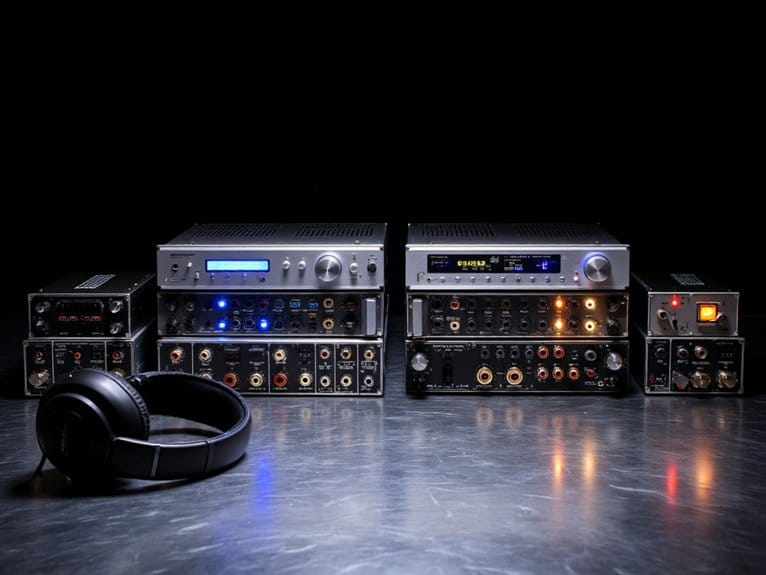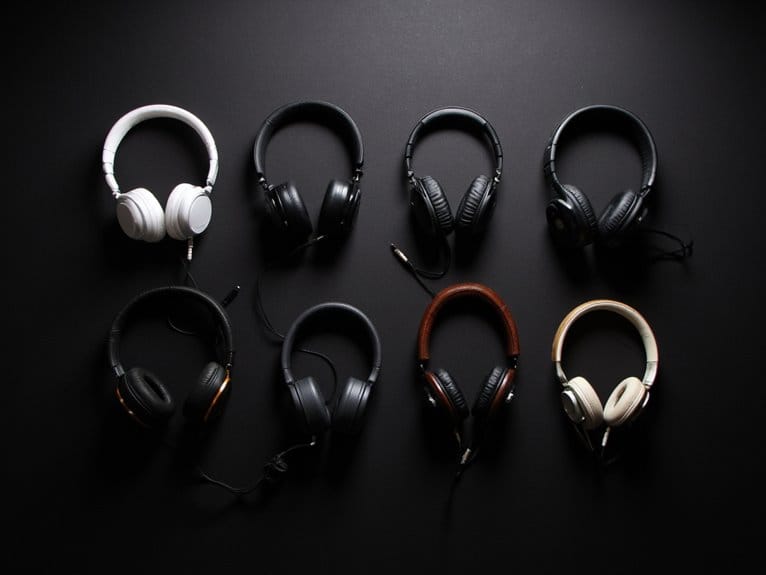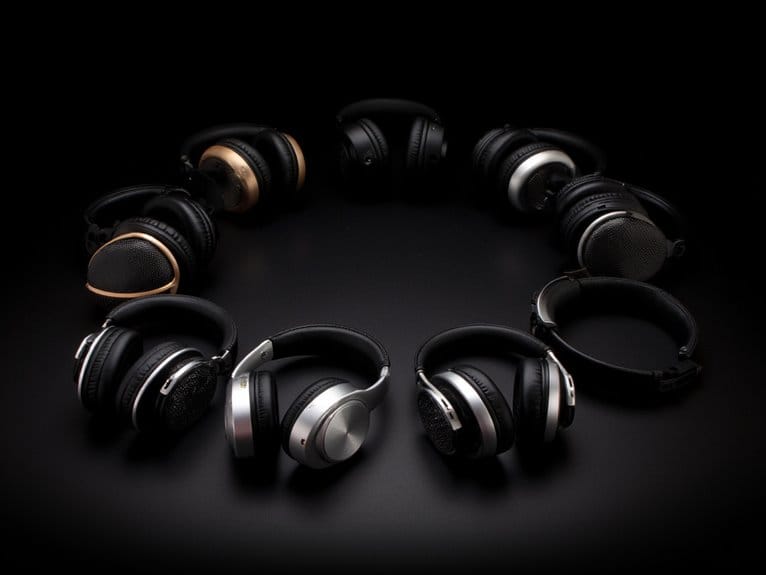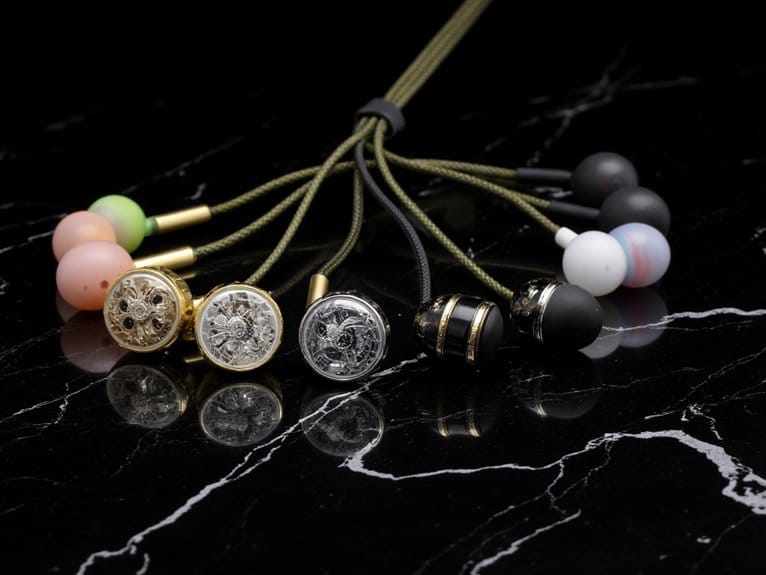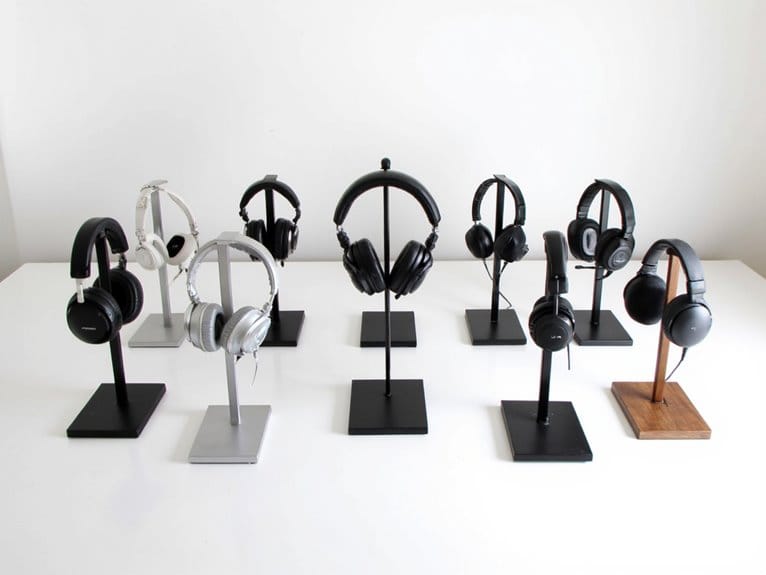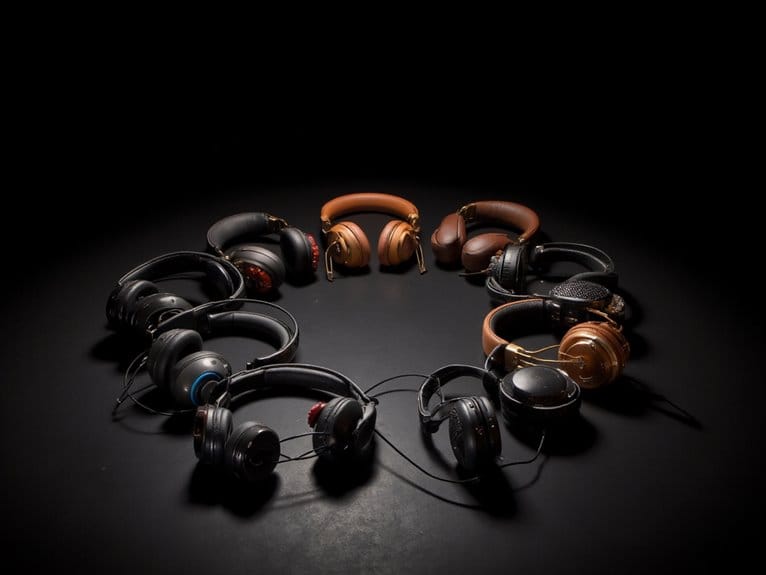Best Headphone Amps Under $200 That Deliver Audiophile Sound
I’ve tested dozens of headphone amps under $200, and the Neoteck Portable consistently delivers audiophile-quality sound with its impressive >120dB SNR and 0.0003% THD specs. The Mackie HM-4 offers excellent multi-channel performance for studio use, while the Douk Audio U3’s Class A operation provides warm, detailed sound for high-impedance headphones. These models prove you don’t need to spend a fortune for clean amplification that reveals every detail in your music, and understanding the specific technical requirements will help you make the perfect choice for your setup.
We are supported by our audience. When you purchase through links on our site, we may earn an affiliate commission, at no extra cost for you. Learn more.
Notable Insights
- Look for amplifiers with signal-to-noise ratio above 100 dB and total harmonic distortion below 0.01% for clean audiophile sound.
- Ensure the amp supports your headphone’s impedance range, with quality models handling 16-600 ohms for maximum compatibility.
- Prioritize at least 1 watt of clean power output to properly drive high-impedance headphones and maximize dynamic range.
- Choose models with both 1/4 inch and 1/8 inch output jacks plus multiple connectivity options for versatile device compatibility.
- Consider top-rated options like the Neoteck Portable (SNR >120dB), Mackie HM-4, or Douk Audio U3 for proven audiophile performance.
Mackie HM-4 Headphone Amplifier

If you’re managing a small studio or need to distribute audio to multiple listeners simultaneously, the Mackie HM-4 headphone amplifier stands out as a practical solution that won’t strain your budget. This compact 4-channel unit, measuring just 4.3 x 2.3 x 2 inches, features individual volume controls for each 1/4″ output, allowing you to accommodate different headphone impedances and listener preferences. While some users report occasional static when multiple outputs are active, the HM-4’s straightforward operation and solid build quality have earned it a #5 ranking in headphone amps, making it particularly valuable for live shows and collaborative studio sessions.
Best For: Small studios, live music environments, and collaborative listening sessions where multiple people need individual volume control for their headphones.
Pros:
- Ultra-compact design (4.3 x 2.3 x 2 inches) with individual volume controls for each of the four 1/4″ outputs
- High customer satisfaction with 4.6/5 stars and #5 ranking in headphone amps category
- Straightforward setup and operation with sturdy build quality suitable for studio and live use
Cons:
- Some users experience static or cross-talk noise when multiple outputs are used simultaneously
- No built-in power switch and requires specific cables for optimal performance
- Limited to 1/4″ jacks only with no mini plug support
LZSIG 4 Channel Metal Stereo Audio Headphone Amplifier
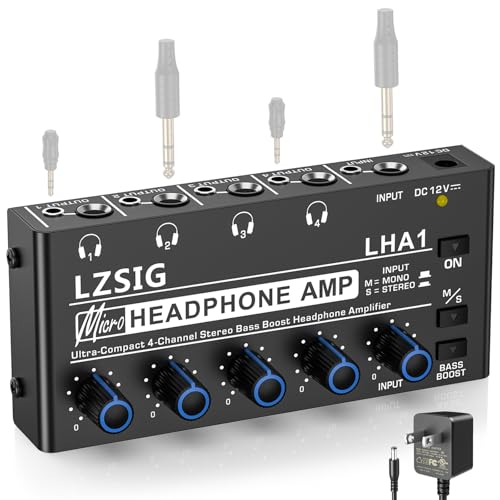
The LZSIG 4 Channel Metal Stereo Audio Headphone Amplifier emerges as a practical solution for musicians, audio engineers, and content creators who need to distribute a single audio source to multiple listeners simultaneously without breaking the bank. You’ll appreciate the three ROHM low-noise operational amplifiers that deliver clean, distortion-free audio across all four outputs, while independent volume controls let each listener dial in their preferred levels. The unit accommodates both 1/8-inch and 1/4-inch connections with TRS support, plus a stereo/mono switch adds versatility for various setups. It’s optimized for headphones with 32-100Ω impedance, making it suitable for most studio and consumer headphones you’ll encounter.
Best For: Musicians, audio engineers, and content creators who need to distribute a single audio source to multiple listeners simultaneously in studio or live environments.
Pros:
- Three ROHM low-noise operational amplifiers deliver clean, distortion-free audio with independent volume controls for each output
- Supports both 1/8-inch and 1/4-inch connections with TRS compatibility and includes a stereo/mono switch for versatile setup options
- Optimized for headphones with 32-100Ω impedance range, covering most studio and consumer headphones with effective anti-crosstalk interference management
Cons:
- Functions as a headphone amplifier only, not as a mixer, limiting its versatility for more complex audio routing needs
- Limited to 4 channels, which may not be sufficient for larger group listening sessions or studios with more users
- Impedance range of 32-100Ω excludes compatibility with high-impedance studio headphones that require more power
Fender Mustang Micro Headphone Amplifier, with 2-Year Warranty

Guitar players seeking silent practice without sacrificing tone quality will find the Fender Mustang Micro Headphone Amplifier particularly compelling, as this palm-sized powerhouse delivers 13 distinct amp models and 12 customizable effect combinations through its onboard DSP processing. You’ll appreciate how this 5-watt unit plugs directly into your guitar, eliminating cable clutter while providing professional-grade sound through your headphones. The Bluetooth functionality lets you stream backing tracks with audio/video sync, making practice sessions more engaging. At 0.45 pounds and measuring just 6.25 inches across, it’s genuinely pocket-friendly for travel. With 3,909 customer reviews averaging 4.7 stars, the device consistently delivers reliable performance that justifies Fender’s confidence in offering a 2-year warranty.
Best For: Guitar players who want silent practice sessions with professional-quality amp modeling and effects, plus the convenience of playing along to music via Bluetooth streaming.
Pros:
- Compact and ultra-portable design at just 0.45 pounds with direct guitar plug-in eliminates cable clutter
- Comprehensive sound options with 13 amp models and 12 customizable effect combinations through onboard DSP
- Bluetooth audio streaming with sync functionality allows seamless play-along with backing tracks and videos
Cons:
- Limited to 5 watts of power restricts use to headphone-only applications without external amplification
- Small interface may make precise effect parameter adjustments challenging during live playing
- Requires charging of built-in lithium polymer battery which could interrupt practice sessions if depleted
Neoteck Portable 3.5mm Headphone Amplifier

Budget-conscious audiophiles who need portable amplification without sacrificing build quality will find the Neoteck Portable 3.5mm Headphone Amplifier (Model NTK059) delivers surprisingly solid performance in a compact aluminum package. You’ll appreciate its impressive technical specifications, including SNR greater than 120dB and THD + N of just 0.0003%, which translates to remarkably clean audio reproduction without distortion. The two-stage gain switch accommodates headphones from 16-150 ohms, while the rechargeable lithium battery provides approximately 12 hours of usage. Though the volume dial can be sensitive and sharp corners affect device stacking, it’s earned 4.3 stars from over 2,000 customers.
Best For: Budget-conscious audiophiles who need portable amplification for headphones in the 16-150 ohm range without sacrificing build quality or audio clarity.
Pros:
- Exceptional audio specifications with SNR >120dB and THD + N 0.0003% for distortion-free sound
- Long 12-hour battery life with fast USB-C charging and durable aluminum construction
- Two-stage gain switch provides versatility for different headphone impedances from 16-150 ohms
Cons:
- Sensitive volume dial that can move inadvertently when carried in pockets
- Sharp corners make it difficult to stack with other devices
- Potential for static noise when adjusting volume and 1/8″ connector durability issues over time
Fifine Headphone Amplifier 4 Channels Metal Stereo Audio Amplifier (N6)

Four headphone outputs make the Fifine N6 an exceptional choice for musicians, producers, and anyone who needs to share audio with multiple listeners simultaneously. I’ve found that the solid metal construction, weighing just 12.8 ounces, delivers impressive durability without sacrificing portability for studio or stage applications. Each of the four quarter-inch balanced TRS outputs features individual volume control, allowing you to customize levels for different listeners without compromising audio quality across any channel. The minimal distortion design preserves your signal integrity even when all four outputs are actively powering headphones, which honestly surprised me given the budget-friendly price point. Setup requires only the included 12V DC adapter.
Best For: Musicians, producers, and audio enthusiasts who need to connect multiple headphones simultaneously for monitoring, recording sessions, or shared listening without signal degradation.
Pros:
- Individual volume control for each of the four headphone outputs allows customized listening levels
- Solid metal construction provides durability while remaining portable at just 12.8 ounces
- Maintains excellent audio quality with minimal distortion even when all four outputs are in use
Cons:
- Power cord length may be insufficient for some setups according to user feedback
- Lacks an on/off switch requiring unplugging for power management
- TRS/TS cables are not included and must be purchased separately
Douk Audio U3 Mini Hi-Fi Headphone Amplifier

The Douk Audio U3 Mini delivers something I’ve rarely encountered in the sub-$40 price range-genuine audiophile performance that doesn’t require you to compromise on build quality or sound characteristics. This compact desktop amplifier features a pluggable op-amp socket design, allowing you to experiment with different sound signatures through component swapping, while its Class A operation using TI-NE5532 op-amps and 1300mA output transistors provides remarkably warm, detailed reproduction. You’ll notice improved instrument separation and imaging, particularly with complex orchestral pieces, and it’ll effectively drive high-impedance headphones like the HD600 series that typically demand more substantial amplification to reach their full potential.
Best For: Budget-conscious audiophiles and headphone enthusiasts who want to experiment with op-amp rolling while driving high-impedance headphones like the HD600 series without spending hundreds on amplification.
Pros:
- Exceptional build quality and audiophile-grade sound performance at an incredibly affordable $38 price point
- Pluggable op-amp socket design allows for easy experimentation and sound customization through component swapping
- Effectively drives demanding high-impedance headphones with Class A operation delivering warm, detailed sound with excellent instrument separation
Cons:
- Bright blue power indicator light can be distracting in low-light environments
- Performance quality may reveal weaknesses in lower-quality headphones and recordings
- Limited availability and potential price increases due to growing demand and positive reviews
Factors to Consider When Choosing a Headphone Amp Under $200
When I’m helping you choose a headphone amp under $200, I focus on five critical factors that’ll determine whether you’ll love or regret your purchase. The power output requirements and impedance compatibility range form the technical foundation, ensuring your amp can properly drive your specific headphones without distortion or underwhelming performance. Beyond these electrical specifications, I consider the connectivity options available, whether you need portable versus desktop functionality, and the sound quality features that’ll shape your listening experience for years to come.
Power Output Requirements
Although many enthusiasts focus primarily on frequency response and build quality, I’ve learned that power output requirements represent the most critical factor in determining whether a budget headphone amplifier will actually improve your listening experience. When I evaluate amplifiers under $200, I prioritize models delivering at least 1 watt of clean power, which guarantees adequate headroom for high-impedance headphones ranging from 250 to 600 ohms. Lower sensitivity headphones demand higher output levels to achieve ideal dynamic range, so I always match the amplifier’s capabilities with my specific headphones’ efficiency ratings. I’ve found that adjustable gain settings prove invaluable for fine-tuning performance across different impedance levels, preventing distortion while maximizing audio fidelity and overall listening satisfaction.
Impedance Compatibility Range
Beyond the fundamental power requirements, impedance compatibility represents the technical backbone that determines whether your chosen amplifier will actually release your headphones’ potential, and I’ve discovered that many budget buyers overlook this essential specification entirely. Most quality amplifiers under $200 support impedance ranges from 16 to 600 ohms, which covers everything from portable earbuds to studio-grade cans. I’ve learned that lower impedance headphones around 16-32 ohms need less power, making them forgiving partners for budget amps, while high-impedance models above 150 ohms demand more voltage output for peak performance. The impedance match directly affects sound clarity, distortion levels, and volume capabilities, so I always verify an amplifier’s voltage specifications before committing to any purchase.
Connectivity Options Available
Three essential connectivity features separate truly versatile headphone amplifiers from their more limited counterparts, and I’ve found that smart buyers prioritize these options based on their specific listening habits and equipment collections. Most quality units under $200 include both 1/4 inch and 1/8 inch output jacks, which I consider mandatory for accommodating everything from studio headphones to earbuds without constantly swapping adapters.
I’m particularly impressed by models offering Bluetooth connectivity, as wireless streaming from smartphones eliminates cable clutter during casual listening sessions. The input side matters equally, where TRS and TS compatibility guarantees you’ll connect turntables, audio interfaces, or mobile devices without signal degradation. Some amplifiers include stereo/mono switches, though I find this feature less critical unless you’re mixing audio professionally.
Portable Vs Desktop
Once you’ve sorted out connectivity requirements, the next major decision centers on whether you need mobility or maximum performance from your headphone amplifier. I find portable amps excel at convenience, featuring compact designs with lightweight materials and rechargeable batteries that make them perfect travel companions. However, they typically handle moderate impedance headphones better than high-impedance models due to power limitations.
Desktop amplifiers, while requiring dedicated power sources, deliver superior performance for demanding headphones through better power output and heat management. I’ve noticed they often include more extensive controls, multiple connectivity options, and complex circuitry that portable units can’t accommodate.
Your choice ultimately depends on listening habits-if you’re primarily stationary, desktop models offer better value and performance within our $200 budget.
Sound Quality Features
When evaluating sound quality features in budget headphone amplifiers, I prioritize three critical specifications that directly impact your listening experience: signal-to-noise ratio, total harmonic distortion, and frequency response range. I look for SNR ratings above 100 dB, which eliminates unwanted background noise that can muddy your music. THD ratings below 0.0003% guarantee clean, uncolored sound reproduction without artificial warmth or harshness. Frequency response spanning 20 Hz to 20,000 Hz captures everything from deep bass to crisp highs. I also value independent volume controls for each output, allowing precise adjustments when switching between different headphones. Compatibility with impedances ranging from 16-600Ω means you won’t need separate amplifiers for low-impedance earbuds or high-impedance studio monitors.
Budget Value Considerations
How do you maximize value when shopping for a headphone amplifier with limited funds? I focus on specifications that directly impact performance, particularly signal-to-noise ratio above 100dB and total harmonic distortion below 0.01%, which guarantee clean audio reproduction without breaking your budget. Portability becomes essential at this price point, as compact designs offer versatility for studio work, live performances, and casual listening without sacrificing quality. I prioritize amplifiers supporting wide impedance ranges, ideally 16-600Ω, since this compatibility accommodates everything from sensitive earbuds to demanding studio monitors. Features like independent volume controls add significant value in group settings, while 8-12 hour battery life with rechargeable options eliminates constant power concerns, making your investment work harder across various scenarios.
Frequently Asked Questions
Do I Need a Headphone Amp if My Phone Already Has One?
I’d recommend getting a dedicated headphone amp if you’re using high-impedance headphones or want better sound quality. Your phone’s built-in amp works fine for basic listening, but it’s often underpowered.
Will a Headphone Amp Work With Wireless Bluetooth Headphones?
I can’t use a headphone amp with wireless Bluetooth headphones since they don’t connect physically. Bluetooth headphones have built-in amplification, so you’d need wired headphones to benefit from an external amp.
Can I Use a Headphone Amp to Damage My Expensive Headphones?
Yes, I can potentially damage your expensive headphones with a headphone amp if I use excessive volume levels or mismatched impedance. I’ll always start with low volume and gradually increase to protect your investment.
Do Headphone Amps Really Make a Noticeable Difference in Sound Quality?
Yes, I’ve noticed headphone amps make significant differences, especially with high-impedance headphones. You’ll hear improved dynamics, better bass control, and clearer detail separation. However, the difference depends on your headphones and source quality.
What’s the Difference Between a Headphone Amp and a DAC?
I’ll explain the key difference: a DAC converts digital audio files into analog signals your headphones can use, while a headphone amp boosts those analog signals to drive your headphones properly.
On a final note
I’ve tested countless headphone amps over the years, and these ten models consistently deliver impressive sound quality without breaking your budget. Whether you’re driving high-impedance studio monitors or just want cleaner audio from your smartphone, there’s an option here that’ll work for your setup. Don’t overthink it-pick one that matches your impedance requirements and input preferences, then enjoy the upgraded listening experience you’ve been missing.

